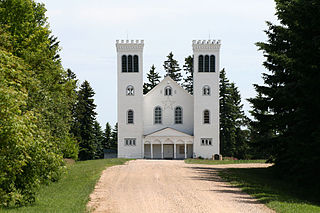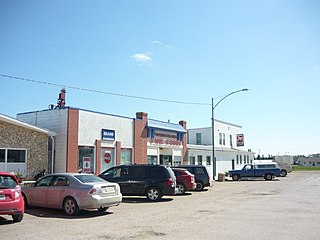Related Research Articles

Humboldt was a provincial electoral district for the Legislative Assembly of Saskatchewan, Canada. Located in central Saskatchewan, this constituency was one of 25 created for the 1st Saskatchewan general election in 1905.

Batoche is a provincial electoral district for the Legislative Assembly of Saskatchewan, Canada. It is located in north central Saskatchewan and has an economy based primarily on mixed agriculture and farm implement manufacturing. Bourgault Industries in St. Brieux manufactures harrows, cultivators, ploughs. The Batoche area is where Louis Riel led his Metis people in an armed uprising against the Canadian government in 1885. Batoche National Historic Site is located in this constituency.

The Saskatchewan Transportation Company (STC) was a Crown corporation in the Canadian province of Saskatchewan responsible for operating intercity bus routes in the province from 1946 to 2017. Created in 1946 by an Order in Council giving the company a mandate to provide service between major urban centres and to as much of the rural population as possible, STC was a wholly owned subsidiary of the Crown Investments Corporation of Saskatchewan.

The Western Development Museum is a network of four museums in Saskatchewan, Canada preserving and recording the social and economic development of the province. The museum has branches in Moose Jaw, North Battleford, Saskatoon and Yorkton. Respectively, each branch focuses on a different theme: transportation, agriculture, economy, and people. The museum is affiliated with the Canadian Museums Association, the Canadian Heritage Information Network, and Virtual Museum of Canada.

Wakaw Lake is a lake in the RM of Hoodoo No. 401 in the central part of the Canadian province of Saskatchewan. It is about 102 kilometres (63 mi) north-east of Saskatoon and 73 kilometres (45 mi) south of Prince Albert. It takes its name from a Cree word meaning "crooked", referring to the curved shape of the lake. The lake is known in Cree as ᐚᑳᐤ ᓵᑲᐦᐃᑲᐣ wâkâw sâkahikan. Wakaw Lake is the source of the Carrot River, which is a 300-kilometre (190 mi) long river that parallels the South Saskatchewan and Saskatchewan Rivers before meeting the Saskatchewan River at The Pas, Manitoba.
The Tlʼetinqox-tʼin Government Office is a First Nations government located in the Chilcotin District in the western Central Interior region of the Canadian province of British Columbia. Governing a reserve communities near Alexis Creek known as Anaham Reserve First Nations or Anaham, it is a member of the Tsilhqotʼin Tribal Council aka known as the Tsilhqotʼin National Government. The main reserve is officially known as Anahim's Flat No. 1, and is more commonly as Anaham. Other reserves are Anahim's Meadow No. 2 and 2A, and Anahim Indian Reserves Nos. 3 through 18. Anaham, or Anahim and Alexis were chiefs of the Tsilhqotʼin during the Chilcotin War of 1864, although they and their people did not take part in the hostilities.

Muenster is a village in the Canadian province of Saskatchewan within the Rural Municipality of St. Peter No. 369 and Census Division No. 15. It is located 9 kilometres (5.6 mi) east of Humboldt on Highway 5. Muenster is named after the city of Münster, Germany.
Pontrilas was a town in the Canadian province of Saskatchewan that no longer exists. At one time Pontrilas was a small farming community approximately 10 miles (16.1 km) south of Nipawin. Access is from Highway 35.

Bruno is a town located 90 km east of Saskatoon and 35 km west of Humboldt. Its current mayor is Dale Glessman.
Kinistino is a town in the Canadian province of Saskatchewan. Kinistino is situated in north-central Saskatchewan. It lies on rich agricultural soil in the valley of the Carrot River, which flows a mile east of the town. Kinistino is located 30 kilometres (19 mi) northwest of Melfort on Highway 3 and 65 kilometres (40 mi) southeast of Prince Albert.

Meacham is a village in the Canadian province of Saskatchewan within the Rural Municipality of Colonsay No. 342 and Census Division No. 11. It is located 69 kilometres east of the City of Saskatoon on Highway 2.
St. Benedict is a village in the Canadian province of Saskatchewan within the Rural Municipality of Three Lakes No. 400 and Census Division No. 15. Located along the Carlton Trail, it is 56 kilometres (35 mi) north of the city of Humboldt off Highway 20.
Crystal Springs is a hamlet in east central Saskatchewan, Canada, located between Waitville and Tway. It was originally known as Bon Eau, which is French for "good water". When English settlers arrived they changed the name to Crystal Springs. This hamlet is about 48 kilometres (30 mi) south-east of Prince Albert.

Black Lake is a Denesuline First Nations band government in the boreal forest of northern Saskatchewan, Canada. It is located on the northwest shore of Black Lake where the Fond du Lac River leaves the lake to flow to Lake Athabasca.
Bayard is an organized hamlet in the RM of Terrell No. 101 in the Canadian province of Saskatchewan. It is located along Highway 715 approximately 4 km southwest of Claybank in the Dirt Hills. The area was populated by German immigrants primarily from Bukovina during the late 19th and early 20th century.
Cudsaskwa Beach is a hamlet in the Canadian province of Saskatchewan. It is a resort community on the northern shore of Wakaw Lake. The name Cudsaskwa is a combination of Cudworth, Saskatchewan, and Wakaw Lake.
St. Isidore-de-Bellevue is a francophone Métis community in Saskatchewan, Canada, northeast of Saskatoon in the rural municipality of St. Louis No. 431, Saskatchewan.

Speers is a village in the Canadian province of Saskatchewan within the Rural Municipality of Douglas No. 436 and Census Division No. 16. The village is located approximately 50 kilometres (31 mi)} southeast of the City of North Battleford on Highway 40.
Rosenhof is a hamlet in Coulee Rural Municipality No. 136, Saskatchewan, Canada. The hamlet is located on Range Rd. 123 4 km south of Highway 363, about 15 km south of Swift Current.
References
52°22′14″N105°13′00″W / 52.37056°N 105.21667°W